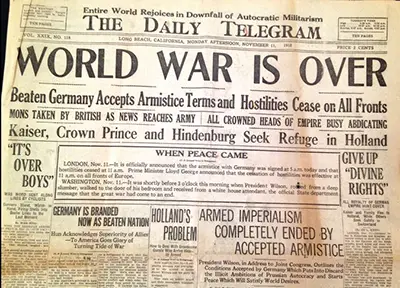World War 1 Ends
U.S.S.R. Backstory
The end of World War I (4 years from July 28th 1914-November 11th 1918) was not without its casualties, and in the end the 4 year war claimed the life of over 9 million soldiers and 7 million innocent civilians. Still considered to be one of the deadliest conflicts in the history of mankind, it involved over 70 million military combatants across the world.
The end of the war came gradually after the failed effort of Germany in the Second Battle of Marne. Here is a summary detailing the end of the war and all of the fallout.


Veterans Day, Armistice Day and Remembrance Day
The war ended on the 11th hour of the 11th day of the 11th month of 1918, creating a holiday that celebrates military men and women. In the United States it is a public holiday that is widely celebrated, and at one point was observed as Armistice Day. In 1954 it was officially named Veterans Day, and is one of the most revered holidays in America.
President Woodrow Wilson delivered a great message on the first Veterans Day on November 11, 1919. He conveyed exactly how the public felt with the war being over, and thanked the brave soldiers and the public for keeping hope.
Armistice Day is celebrated every year on November 11, and is a commemoration of the armistice that was signed. It coincides with Veterans Day, with the first being celebrated at Buckingham palace with King George the V. In modern times Armistice Day is celebrated at an 11:00 a.m. ceremony in London. The Cenotaph is the main location, and it is set up by the Royal British Legion. The main difference between Armistice Day and Veterans Day is that the former represents both living and dead service members.
Remembrance Day is a part of the Commonwealth of Nations culture, and was a tradition put into motion by King George V in 1919. It is also celebrated in non-Commonwealth countries, proving just how much World War I reached the entire world. Remembrance Day is celebrated simultaneously with Armistice Day, with public parades and moments of silence.

Armistice of 11 November 1918
The Allies and Germany signed the Armistice to officially end the War. This made the defeat of Germany official, and ended a 4 year war. U.S. President Woodrow Wilson and Commander of the Allied Armies Ferdinand Foch played a huge role in the surrender, as their Fourteen Points statement laid out policies for world peace.
President Wilson gave the speech on January 8th 1918, and it was addressed by Germany at length after they signed peace treaties with Russia. While many Europeans agreed with the Fourteen Points, there were some Allied detractors that were skeptical of its influence.
The many layers of the Armistice were often complex, and in summary it was like hitting the reset button. The most controversial part of it was the exchange of prisoners and promise of reparations, promises that some countries had to fight for even after the Armistice was signed. Even with all sides agreeing on peace, six months of negotiations were needed to conclude it and create the Treaty of Versailles.

Legacy of the The Schlieffen Plan
The Schlieffen Plan is one of the most brilliantly concocted military strategies to date, and almost brought victory to undermanned Germany. The offensive minded plan was indeed a blueprint for victory, and would have succeeded if not for the late inclusion of other countries joining the Allied forces.
One of the hitches in the plan was Helmuth von Moltke the Younger, who not only strayed away from the blueprint, but possibly ruined some key victories in The Schlieffen Plan. Several books have been printed on the subject of its effectiveness, and many historians point to him as the deciding factor.
There are also books that point the finger at the unpredictability of war, sparing Helmuth von Moltke the Younger from the blame. That may very well be true, as no one could have predicted any of the days in World War I. The true effectiveness of the The Schlieffen Plan will remain a mystery, but it will still be recognized as a huge tactical win for the Germans.



